|
|
|
Benefits of Breastfeeding for the Mother
Benefits of Breastfeeding > for Infant • Mother • Family • Hospital • Environment & Society • Other
Studies indicate that breastfeeding helps improve mothers' health, as well as their children's. A woman grows both physically and emotionally from the relationship she forms with her baby. Just as a woman's breast milk is designed specifically to nourish the body of an infant, the production and delivery of this milk aids her own health.
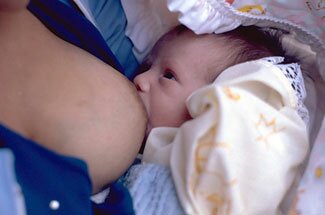
WHO
- Breast milk is always fresh, perfectly clean, just the right temperature, and is the healthy choice at the least cost.
- Breastfeeding is easy, even if it sometimes requires an initial period of learning and adapting for mother and baby.
- Breastfeeding requires no preparation, sterilization, etc. of bottles and formula (often while baby cries…)
- Breastfeeding is a cost effective way of feeding an infant, providing the best nourishment for a child at a small nutrient cost to the mother.
- Breastfeeding is possible throughout pregnancy, but generally milk production will be reduced at some point.
- Frequent and exclusive breastfeeding can delay the return of fertility through lactational amenorrhea, though breastfeeding is an imperfect means of birth control.
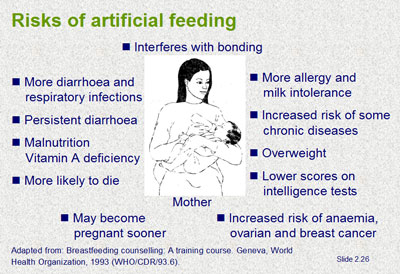
Bonding
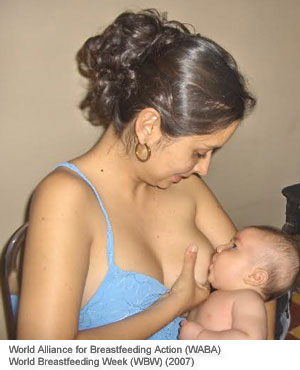
- During breastfeeding beneficial hormones are released into the mother's body and the maternal bond can be strengthened.
- A woman's ability to produce all of the nutrients that her child needs can provide her with a sense of confidence. Hormones released during breastfeeding help to strengthen the maternal bond.
- Researchers have pointed out that the bond of a nursing mother and child is stronger than any other human contact. Holding the child to her breast provides most mothers with a more powerful psychological experience than carrying the fetus inside her uterus.
The relationship between mother and child is rooted in the interactions of breastfeeding. The emotional health of the mother may be enhanced by this relationship she develops with her infant during breastfeeding, resulting in fewer feelings of anxiety and a stronger sense of connection with her baby. This feeling sets the health and psychological foundation for years to come.
- Teaching partners how to manage common difficulties is associated with higher breastfeeding rates. Support for a mother while breastfeeding can assist in familial bonds and help build a paternal bond between father and child.
Breast Milk Expression
- If the mother is away, an alternative caregiver may be able to feed the baby with expressed breast milk. The various breast pumps available for sale and rent help working mothers to feed their babies breast milk for as long as they want. To be successful, the mother must produce and store enough milk to feed the child for the time she is away, and the feeding caregiver must be comfortable in handling breast milk.
Hormone Release
- Uterus returns to normal size more quickly and mother has reduced blood loss
- Breastfeeding releases oxytocin and prolactin, hormones that relax the mother and make her feel more nurturing toward her baby. Breastfeeding soon after giving birth increases the mother's oxytocin levels, making her uterus contract and return to its normal size more quickly and reducing bleeding. Pitocin, a synthetic hormone used to make the uterus contract during and after labour, is structurally modelled on oxytocin.
Weight Loss
- Mothers who breastfeed are more likely to return to their prepregnancy weight than mothers who formula feed. Breastfeeding reduces the risk for long-term obesity.
- Breastfeeding appears to reduce the risk of obesity and hypertension.
- As the fat accumulated during pregnancy is used to produce milk, extended breastfeeding—at least 6 months—can help mothers lose weight. However, weight loss is highly variable among lactating women; monitoring the diet and increasing the amount/intensity of exercise are more reliable ways of losing weight.
- Mothers burn many calories during lactation as their bodies produce milk. In fact, some of the weight gained during pregnancy serves as an energy source for lactation.
- The 2007 review for the AHRQ found "The effect of breastfeeding in mothers on return-to-pre-pregnancy weight was negligible, and the effect of breastfeeding on postpartum weight loss was unclear."
Helps Birth Spacing
- In developing countries, exclusive breastfeeding reduces total potential fertility as much as all other modern contraceptive methods combined. By spacing births, breastfeeding allows the mother to recuperate before she conceives again.
Natural Postpartum Infertility
- Exclusive breastfeeding for the first 6 months postpartum, in the absence of menses, is 98 percent effective in preventing pregnancy (similar to oral contraceptives). It is natural, and totally free. This is the Lactation Amenorrhea Method (LAM).
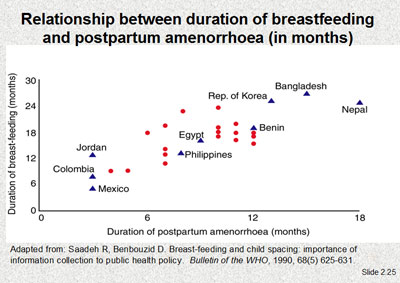
- Women who nurse frequently during exclusive breastfeeding remained amenorrhoeic longer than infrequent nursers, introduced supplements later and did not resume menses as promptly thereafter. Duration of exclusive nursing and night nursing after supplementation were the major influences on amenorrhoea.
- Breastfeeding may delay the return to fertility for some women by suppressing ovulation. A breastfeeding woman may not ovulate, or have regular periods, during the entire lactation period. The period in which ovulation is absent differs for each woman. This Lactational amenorrhea has been used as an imperfect form of natural contraception, with a greater than 98% effectiveness during the first six months after birth if specific nursing behaviors are followed -- more effective than a diaphragm or condom.
- Scientists believe this process prevents more births worldwide than all forms of contraception combined. In Africa, breastfeeding prevents an estimated average of four births per woman, and in Bangladesh it prevents an estimated average of 6.5 births per woman.
- It is possible for some women to ovulate within two months after birth while fully breastfeeding.
Long-term Health Effects
The more months a woman has spent breastfeeding, the greater the beneficial effect. The long-term health benefits of breastfeeding for nursing moms are less often discussed, but they are vast, and include protection against a wide array of life-threatening diseases such as:
-
Reproductive cancers
It's well established that women who have their first baby after age 25 or who have fewer than four children are more likely to get breast cancer than their counterparts who give birth at a young age or have a lot of kids. But research has shown that nursing for six months or more negates these risks. Prolonged nursing also lowers a woman's lifetime risk of ovarian and endometrial cancer, probably because it suppresses ovulation—and the ovulatory hormones that play a role in these cancers—during those first few months that she nurses exclusively.
Women who lactate for a total of two or more years reduce their chances of developing breast cancer by 24 percent.
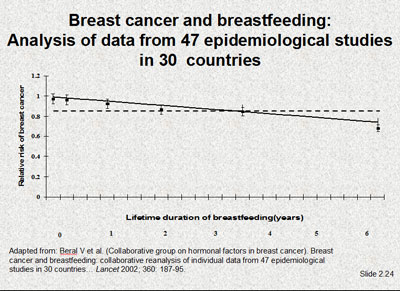
- Among both premenopausal and postmenopausal women, risk of breast cancer decrease with increasing duration of lifetime lactation experience although the effect was consistently stronger for premenopausal women.
- After controlling for age at first full term pregnancy and other potentially compounding factors, parity and duration of breast feeding also had a strong influence on the risk of breast cancer. Compared with parous women who never breast fed, women who had breast fed for 25 months or more had a lower relative risk.
- If women who do not breastfeed or who breastfed for less than 3 months were to do so for 4 to 12 months, breast cancer among parous premenopausal women could be reduce by 11%; if all women with children lactated for 24 months or longer, the incidence might be reduced by nearly 25%.
- Women who were breastfed as infants, even if only for a short time, showed an approximate 24% lower risk of developing premenopausal or postmenopausal breast cancer, compared to women who were bottle-fed as an infant.
- A protective effect against uterine cancer was found for women who breastfeed. This protection increases with breastfeeding duration.
- Breastfeeding should be added to the list of factors that decrease ovulatory age and thereby decrease the risk of ovarian cancer.
- Lactation provides a hypoestrogenic effect with less stimulation of the endometrial lining. This event may offer a protective effect from endometrial cancer.
- Breastfeeding decreases the risk for and incidence of thyroid cancer
-
Heart disease
In 2009, researchers found that women who nursed for at least 24 months over the course of their reproductive lifespan had a 23 percent lower risk of developing heart disease. While the reason is still unknown, researchers theorize that it could be due to the beneficial effects that nursing has on the body's metabolism of sugar and fats. Nursing may also decrease visceral fat—the dangerous kind that collects around the abdominal organs—and promote healthier fat storage on the hips and thighs. One thing nursing doesn't appear to do: trigger weight loss. While it takes plenty of calories to produce breast milk, nursing moms usually find that their appetites increase, causing them to eat more.
- A 2009 study indicated that lactation for at least 24 months is associated with a 23% lower risk of coronary heart disease.
-
Rheumatoid arthritis
A number of studies have linked breastfeeding to protection against rheumatoid arthritis. One from Harvard's Brigham and Women's Hospital found that nursing for a total of two years decreased the risk by 50 percent, while nursing for 12 to 23 months lowered risk by 20 percent. Nursing seems to permanently alter levels of female sex hormones, like estrogen and certain androgens, thought to play a role in this debilitating condition.
-
Diabetes
The latest study adds to evidence that nursing protects against type 2 diabetes. That's likely because lactation makes cells more sensitive to the hormone insulin. (In fact, diabetic mothers who breast-feed usually require less insulin when they nurse.) It could also be due to nursing's effect on where fat is stored: on the hips and thighs rather than on the belly. Excess abdominal fat, often acquired during pregnancy, is a key risk factor in adult diabetes.
- Diabetic women improve their health by breastfeeding. Not only do nursing infants have increased protection from juvenile diabetes, the amount of insulin that the mother requires postpartum is decreased.
- A woman suffering from Gestational Diabetes has less risk of developing type-2 Diabetes later on if she breastfeeds after that pregnancy.
One More Way to Avoid Diabetes: Breastfeed - 27 Aug, 2010
Breastfeeding May Lower Moms' Diabetes Risk - 27 Aug. 27 2010
- Breastfeeding appears to reduce the mother's risk of developing osteoporosis in later years. This risk, for a woman who did not breastfeed her baby, was four times higher. Although mothers experience bone-mineral loss during breastfeeding, their mineral density is replenished and even increased after lactation.
- Although the 2007 review for the AHRQ found "no relationship between a history of lactation and the risk of osteoporosis", mothers who breastfeed longer than eight months benefit from bone re-mineralisation.
- Reduced risk of post-partum bleeding.
- Breastfeeding decreases the risk for and incidence of lupus
- Exclusive breastfeeding may reduce the risk of anemia by delaying the return of the menstrual cycle for 20 to 30 weeks. Breastfeeding decreases the risk for and incidence of iron deficiency - anaemia
- According to a Malmö University study published in 2009, women who breast fed for a longer duration have a lower risk for contracting rheumatoid arthritis (RA) than women who breast fed for a shorter duration or who had never breast fed.
- Breastfeeding lowers the risk of hip fractures (Riordan & Auerbach, 1999).
Emotional Health
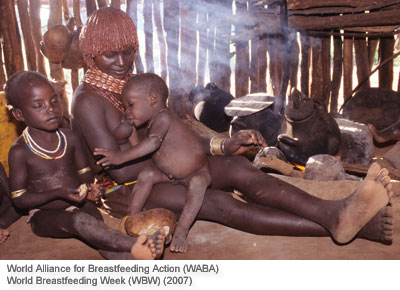
Many mothers also get emotional benefits from breastfeeding because of the closeness of this interaction with the baby and from the satisfaction of helping to nourish their babies.
- At one month postpartum, women who breastfed their infants had scores indicating less anxiety and more mutuality than the women bottle feeding their infants.
- Some research suggest that mothers who breastfeed their babies have fewer episodes of post-delivery depression.
- Breastfeeding comforts a toddler when they are tired, upset, sick or hurt. Extended breastfeeding can make mothering a toddler easier during those times (LLL).
- Helps mother get needed rest by requiring that she sit or lie down with baby every few hours to feed.
- Breastfeeding women report psychological benefits such as increased self-confidence and a stronger sense of connection with their babies.
Many societies and cultures also encourage mothers to breastfeed, which can offer support to a new mother.
Saves Money
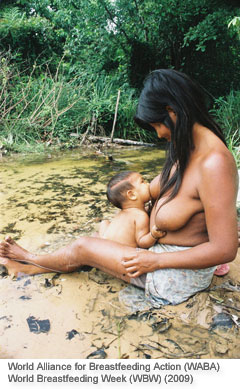
- Breastfeeding is among the most cost-effective of child survival interventions. Households save money; and institutions economize by reducing the need for bottles and formulas. By shortening mothers' hospital stay, nations save foreign exchange.
- Because breastfed babies are healthier, their mothers miss less work and spend less time and money on pediatric care thus reducing healthcare costs to family in Doctor office visits, prescriptions, over the counter medicine purchases, and hospitalizations.
- Moms miss less time off from work due to child related illnesses
Benefits of Breastfeeding > for Infant • Mother • Family • Hospital • Environment & Society • Other
23 April, 2012
|
